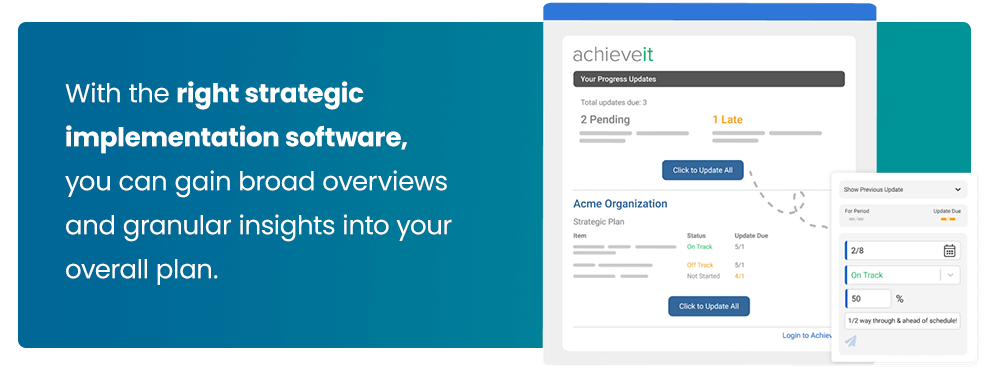Implementing a new software program or business process can feel like buying a pricy piece of workout equipment for your home. You get a shiny new machine and create grand ideas of the future, but if you don’t prioritize the change and implement a strategy, it just starts collecting dust. Implementing change requires a systematic and thoughtful approach, especially in organizations with many moving parts.
If you want to ensure success with a new system or solution, you’ll need a plan for strategic implementation. This process is nonlinear and can be complex, but we’ve outlined some of the most important elements and tips for implementing strategic planning in your organization.
In This Article
- What Is Strategy Implementation?
- 7 Common Reasons for Strategy Implementation Failure
- 4 Musts for Avoiding Strategy Implementation Failure
- Treat Software as a Catalyst for Transformation — Not the Solution
- Culture Is Your Secret Driver
- The Heart of Transformation Is in True Cultural Change
What Is Strategy Implementation?
Strategy implementation is all about how your organization turns plans on paper into real-world activities that support your goals and objectives. While your strategy might have a detailed outline, a strategic implementation plan addresses its execution. It includes elements like organizing activities, tracking progress, and ensuring you have the resources and support systems to ensure successful change.

Strategic implementation plans also prioritize the organization’s culture. Elements like communication, respect and transparency go a long way in implementing the project and facilitating long-term change. Other vital aspects of implementing strategic plans include measuring progress, aligning strategy with overarching goals and adapting the plan as conditions change.
An implementation plan depends on a solid strategy and vice versa. They work hand in hand to support various business efforts, from reaching new markets to adopting a new training program.
7 Common Reasons for Strategy Implementation Failure
Many business leaders start with beautifully laid plans but wonder why they didn’t work. Often, strategic implementation holds the answer, especially if it doesn’t exist at all.
Businesses might struggle with their implementation strategies for many reasons, such as:
- Incompetent management: Managers who don’t contribute or motivate your team can hurt engagement and productivity and even increase stress, greatly affecting your ability to implement strategic planning. To earn the team’s trust, management must show respect, integrity and fairness and promote work-life balance. They must have conflict resolution and problem-solving skills, too. Make sure your managers truly have the skills for the job, understand their responsibilities and can offer competent support throughout strategic implementation.
- Vague strategic vision: If your strategic vision isn’t crystal clear, you may have trouble communicating and identifying effective solutions. Enthusiastically articulate your concrete values and goals with the team, and review them often to keep their eyes on the prize. Other ways to strengthen your vision include identifying realistic goals and accomplishments, adjusting unsuccessful strategies, setting priorities for change and continuously seeking out ways to improve. Consider developing some strong core capabilities that can help you across different plans and strategies.
- Inadequate strategy: A clear vision isn’t necessarily an effective one. When developing your strategy, think about the unique ways in which you can accomplish your goals more efficiently than the competition. Leverage these advantages while considering a broad umbrella of factors, including your budget and potential obstacles. A comprehensive strategy can help you build a strong foundation.
- No implementation plan: An implementation plan creates clear, definite procedures for reaching goals and objectives. Without it, you may struggle to connect your strategy to your desired achievements. As you develop your plan, consider your current business operations and initiatives, the state you want to achieve through your strategy and the specific steps required to facilitate growth in that direction. Analyze your strengths and weaknesses to move from planning and outlining to implementation and execution.
- Lack of planning and control: Organizational issues can impede any implementation, but strategic planning and good time management practices can help mitigate them. While delegating is valuable, you must make these decisions responsibly and maintain visibility. Staying on top of all tasks can help maintain control while balancing efficiency. It can also help avoid problems and promote accountability, further supporting a sense of control.
- Neglect of political interests: Businesses don’t often consider how politics can support their strategies, but this angle is worth considering. Explore strategies that could influence public policies and what conditions would cause those strategies to support performance goals and your competitive advantage. Although a political strategy can be risky, it could attract attention to your business and help you take control of the big picture.
- Culture of fear: If employees hesitate to share opinions, ask questions or collaborate on creative ideas, you might have a culture of fear. A toxic workplace culture leads about a third of employees to look for a new job. Micro-managing is a common culprit that can increase stress and adversely affect morale and participation. You can fight the culture of fear by focusing on building trust, listening skills and respect and encouraging risk-taking and experimentation.
Many change management strategies fail because leaders underestimate the role of organizational culture in their ability to create and sustain change. It’s easy to see why so many businesses focus more on technology than cultural elements — software is simple and finite, while change management is messy, nonlinear and requires long periods of focused patience.
Short-term goals, like adding software, are essential, but they are not the endpoint for strategic implementation. You’ll need new ways of thinking to get the ball rolling.
4 Musts for Avoiding Strategy Implementation Failure
Promoting those new ways of thinking calls for several must-have elements of a business strategy implementation plan. To avoid failure, organizations must consider various elements and create a solid foundation for implementation activities. Below are four things to do during strategic implementation planning that can help support your success:
1. Track From a High Level
Many people like to track progress with granular, easy-to-spot tasks like sending emails or updating proposals. Unfortunately, these tasks don’t always connect well with what you want to achieve. Your implementation’s strategic plan must include action items that relate back to the overarching goals of your organization. If you track irrelevant items, you may wonder why you aren’t seeing results despite all your progress.

Leaders should understand this connection and ensure they track relevant tasks and metrics. A higher-level approach to tracking helps minimize unnecessary work and align efforts with your primary goals and objectives.
2. Create a Cadence of Accountability
Accountability is crucial, but it’s easy to lose sight of it when everyday responsibilities take over. Leaders can create more effective accountability by ensuring clarity and frequency. Clarity comes from elements like transparency, ownership and straightforward deadlines. Frequency will vary by team and project, but leaders should establish a regular schedule for checkizng in and sharing updates, such as daily, weekly or monthly discussions.
These two aspects help ensure each employee understands their role and responsibility to the team. It makes accountability a core part of the day-to-day workflow and something that all team members share a commitment to.
3. Link Quantitative and Qualitative Measurements
You can measure progress in many ways, but always back up qualitative goals with quantitative metrics. “Foster a culture of accountability” might be a great qualitative goal, but you can’t track it. Instead, you could track this goal by measuring how many teams perform regular status updates or which leaders have completed culture-related training. Concrete and relevant quantitative metrics offer a means of following up on more abstract concepts.
Similarly, by backing up quantitative information with qualitative data, you provide context for the goal, ensuring more informed decision-making. Say you’re considering reducing the frequency of project check-ins to boost efficiency. By understanding the impact of these updates on your goal of improving accountability, you can make a more informed decision on whether reducing them makes sense.
4. Decide on a Software Tool to Drive It Home
Measuring and tracking all of this information can get complex. A strategic implementation software platform is purpose-built to eliminate the burden of creating, tracking, assigning and reporting on change management processes. Look for a platform that offers the right amount of flexibility and structure for your implementation strategy and planning preferences. With the right system, you can gain broad overviews and granular insights into your overall plan.

Treat Software as a Catalyst for Transformation — Not the Solution
Software and other technologies can support successful strategy implementation, but they are not the end goal. Equating your software with your end goal can mean connecting a long-term desired state with a solution that only lasts for a short time.
While necessary for your organization’s overall development, these events and technologies are catalysts that should serve as jumping-off points for the rest of your transformation. Use them to spark excitement and create focus, but implement a strategic plan to carry the change long past the initial installation.
Culture Is Your Secret Driver
Culture is a foundational element of any successful strategy implementation, driving change management efforts for long-term sustainability. Effective leaders know that true work begins post-implementation, and they champion the desired activities and mindsets for change. They alter organizational culture until the change is as familiar and routine to teams as their morning commutes. To get there, these leaders often break cultural change down into manageable actions and pieces of work.
Promoting cultural changes requires high levels of emotional intelligence, as leaders must demonstrate skills like consistent listening, anticipating roadblocks and cheerleading. You’ll find many flavors of change management, but here are some best practices for strategy implementation often used by effective leaders.
“Unbox” Your Strategic Implementation
Many businesses develop a wide-reaching strategy designed to span silos and connect the organization across multiple initiatives — but they create this plan within its own silo. Instead of making your plan behind closed doors, invite your team to the strategic development process. Don’t assume you have their buy-in — earn it with thorough discussions about how the change will affect their roles and what resources they need to succeed.
This approach helps move your strategy out of the executive suite — AKA “the box” — and obtains direct input from your team. You will likely uncover valuable information to better align your objectives. You also give your teams more motivation and capability to execute the plan since they have a say in it and can address potential hiccups or needs executives may have overlooked.
Exceed Alignment and Build Transparency
If employees don’t understand how their role supports the overall mission, they won’t support the cultural shift you’re after. They may also lack the motivation or context to play their roles effectively. For many companies, the extent of sharing a business strategy implementation plan is emailing it to team members. While communicating responsibility for tasks is an important first step, best-in-class organizations go much further.
These businesses explain how and why each team’s responsibilities are crucial to the organization and the strategic implementation. Clearly show their role, what you want from them and how you’ll measure it. This effort is essential for building a sense of purpose within teams and taking alignment to the next level.
Create Focus and Discipline
Many organizations perform quarterly status meetings, but what happens during the time in between? These gaps often provide more opportunities for people to prioritize other responsibilities and let change management fall to the wayside. More frequent check-ins can help maintain focus and build discipline while supporting the cadence of accountability we discussed earlier. Once you’ve aligned your organization’s goals with your strategy, consider taking 30-60 minutes once or twice a month to evaluate progress and check in with other players.
This approach helps team members keep their responsibilities top of mind and further ingrains the importance of plan execution at every level.

Place Multiple Motivational Bets
In his book “Stacking the Deck,” former Charles Schwab CEO David Pottruck divides the general workforce into three categories based on their acceptance of change. About 5% of workers will always welcome and embrace the change, while 15% never will, no matter what you do. He says that 80% of people can be leaders or detractors, depending on which of the other two groups resonates with them more.
Organizational leaders must capture that 80% and empower them to be change agents within the organization. However, the best methods of appealing to these individuals can vary widely. Some might respond well to competition, while others prefer public recognition or fear failing in their roles.
Pottruck suggests employing as many motivational methods as possible until your team starts moving in the same direction. You may need to use several types of stimuli to get the desired response. By appealing to as many motivational styles as you can, you reduce the risk of your 80% going in the wrong direction and fueling resistance.
The Heart of Transformation Is in True Cultural Change
Software and new business processes can kick off exciting changes in your organization, but they aren’t long-term solutions. By using them as rallying points and resources, you can create excitement around a strong vision, but true change is rooted in the culture created at the top. Try using the strategies we’ve discussed to set yourself up for success during strategic implementation.
When you’re ready to make long-lasting change, our strategy management solutions can help you gain complete visibility into your implementation plan. Automate tracking and updates, centralize information and drive accountability with dedicated software and support from our experienced team of strategy professionals. Request a demo today to see how AchieveIt can support your strategic implementation plan and facilitate long-lasting change.



